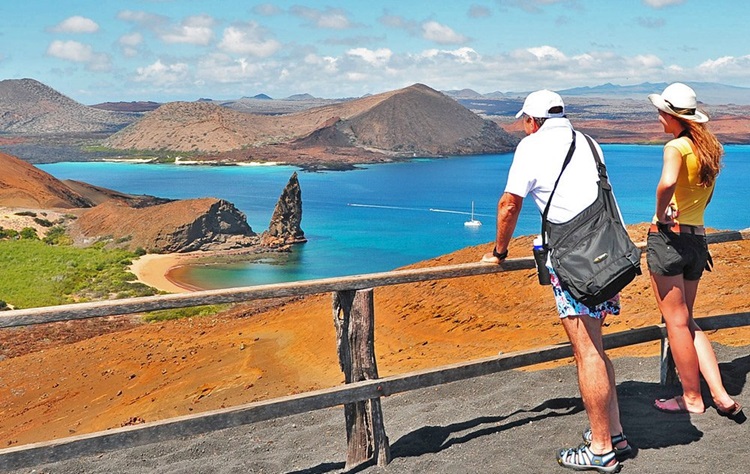Whenever people asked us about our favorite travel destination, we never knew what to say because each place has its own special charm. However, after visiting the Galápagos Islands, we can confidently say that surpassing this experience will be difficult. It was a journey filled with constant wonder, salty tranquility, and an almost childlike excitement.
We shared beaches with sea lions, swam alongside penguins, walked with giant tortoises, strolled around flamingo lagoons, snorkeled through lava tunnels among multicolored fish, and even set foot on an active volcano. The Galápagos Islands are truly unique, and we made the most of every single day.
That said, fulfilling this dream without breaking the bank is not easy. If you also want to explore the Enchanted Islands on your own as affordably as possible, this guide is for you. Here, you’ll find all the necessary information to plan your trip to the Galápagos Islands: what to see on each island, the best tours, how to get there and move between islands, where to stay, how many days to dedicate, the best time to go, and more.
Galápagos Islands: Essential Information
The Galápagos Islands have been a protected National Park since 1959, with specific rules in place, such as not bringing external products into the ecosystem and maintaining a minimum distance of two meters from the animals. Here are some key facts:
- Number of Islands: 18 major islands (over 1 km²) and several smaller islets. The three main islands where travelers usually stay are Santa Cruz, San Cristóbal, and Isabela.
- Currency: U.S. Dollar (USD). ATMs and card payment options are scarce, so carrying cash is crucial.
- Daily Budget: Expensive. Costs vary depending on whether you travel independently, take a cruise, and your travel style.
- Climate: Pleasant year-round but unpredictable.
- Language: Spanish (Galápagos is part of Ecuador).
- Population: Approximately 25,000 people. Residency is strictly regulated.
- Time Zone: 6 or 7 hours behind Spain, depending on daylight savings time.
- Tipping: Usually included in bills (about 10%), but optional.
- Prepaid Mobile Internet: $10 for 2GB with Claro.
Planning Your Trip to Galápagos
While you can visit the Galápagos Islands without a strict itinerary, planning ahead will help you maximize your trip. Since your time and budget may be limited, consider these factors:
- Choose Your Base Islands
- Depending on your interests and available time, decide which islands will serve as your base. The main three islands are:
- San Cristóbal: Great for sea lions and diving.
- Santa Cruz: The busiest island with the best infrastructure.
- Isabela: Known for its natural beauty and relaxed atmosphere.
- Depending on your interests and available time, decide which islands will serve as your base. The main three islands are:
- Book Tours in Advance
- Some of the best experiences require boat trips from the main islands, so researching and booking tours in advance is advisable. We recommend using Chokotrip, which partners with local tour operators. Booking in advance also reduces the amount of cash you’ll need to carry.
- Find Affordable Accommodation
- Check out choko.host, a platform that offers budget-friendly local accommodations. Booking through their link gives you a $20 discount on your first reservation, and 5% of profits support social initiatives in Galápagos.
Best Time to Visit Galápagos
There is no bad time to visit the Galápagos Islands. However, three factors may influence your decision:
- High Tourist Seasons: Prices increase, and tours sell out quickly during peak travel periods:
- December & January (Christmas and New Year holidays)
- Easter Week
- June to August (Summer holidays)
- Weather Conditions
- December to May: Warm, humid, occasional showers, calm seas, and ideal water temperatures for swimming and snorkeling.
- June to December: Cooler, drier, overcast skies, rougher seas, but richer marine life.
- Wildlife Activity
- Certain species are more visible at specific times of the year, so plan accordingly if you have a particular interest in a specific animal.
Visa Requirements for Ecuador and Galápagos
Most European citizens receive a free 90-day tourist visa upon arrival in Ecuador. Ensure your passport is valid for at least six months before traveling. Always check your country’s specific visa requirements in advance.
How to Get to Galápagos
The only way to reach the Galápagos Islands is by air, with flights departing from Quito or Guayaquil (Ecuador). Generally, flights are cheaper from Guayaquil. Use flight comparison tools like Skyscanner or Kiwi to find the best deals.
Island Hopping: How to Move Between Islands
- Public Ferries: The most budget-friendly way to travel between islands. Tickets cost around $30 per trip and take 2-3 hours.
- Speedboats: Faster but more expensive.
- Small Planes: A convenient but costly option for travel between major islands.
Must-See Attractions on Each Island
- San Cristóbal:
- La Lobería (sea lion colony)
- Kicker Rock (snorkeling and diving site)
- Puerto Chino Beach (scenic wildlife spot)
- Santa Cruz:
- Charles Darwin Research Station (giant tortoises conservation center)
- Tortuga Bay (stunning white sand beach)
- Los Gemelos (twin volcanic sinkholes)
- Isabela:
- Sierra Negra Volcano (active volcano hike)
- Concha de Perla (snorkeling with marine life)
- Las Tintoreras (sharks, penguins, and blue-footed boobies)
Budget Tips for Visiting Galápagos
- Book Flights in Advance: Prices increase closer to the departure date.
- Travel Independently: Avoid expensive cruises and opt for day tours instead.
- Use Local Transportation: Public ferries are more affordable than flights or private boats.
- Buy Food in Mainland Ecuador: Groceries are significantly cheaper outside the islands.
- Stay in Budget Accommodations: Hostels, guesthouses, or rentals via choko.host are great options.
Which Airline to Fly to Galápagos?
Airlines Flying to Galápagos
If you’re planning a trip to the Galápagos Islands, you have a few airline options. Flights depart from Quito and Guayaquil, operated by Avianca, Latam, and Aeroregional. To secure the best fare, it’s essential to compare prices across these airlines using platforms like Skyscanner or Kiwi. Additionally, having some flexibility with your travel dates can make a significant difference, as prices can vary by up to $300 depending on the day of travel.
Galápagos Airports and Cost-Saving Tips
There are two airports in the Galápagos Islands:
- Baltra Airport (GPS) – Located on Santa Cruz Island
- San Cristóbal Airport (SCY) – Located on San Cristóbal Island
A smart way to save money and time is to book your flight into one island and depart from the other. This strategy can help you avoid an inter-island boat trip, which costs around $30.
In our search, Avianca offered the cheapest flights:
- One-way: Guayaquil → San Cristóbal
- Return: Baltra (Santa Cruz) → Guayaquil
- Price: $557 / €491 for two people
Booking in advance is recommended, especially during peak seasons. However, we secured a great deal with Avianca even with less than a month’s notice. While TAME was previously an option, this airline no longer operates.
Our flight itinerary:
- Date: March
- Airline: Avianca
- Total cost: $279 per person (€245)
- Other options: Latam and TAME (before ceasing operations) had the same flight for $400 per person
Top Tour from Santa Cruz: Bartolomé Island
One of the must-do tours from Santa Cruz Island is the Bartolomé Island tour, which offers breathtaking landscapes and the chance to see unique wildlife.
Galápagos Entry Requirements and COVID-19 Protocols
Travel to the Galápagos Islands is now unrestricted. As of February 2023, most COVID-19 regulations have been lifted, including health declarations and mandatory masks. Before traveling, check updated entry requirements at Chokotrip.
Travel Insurance for Galápagos
While travel insurance is not mandatory, it is highly recommended. Medical emergencies, trip cancellations, and lost luggage can be costly. We suggest IATI travel insurance, which offers a 5% discount when booked through their website.
For divers, having dive insurance is crucial. AXA Sub and ExtraSub are good options depending on your travel frequency. Additionally, public healthcare in Ecuador is free, as we personally experienced in Galápagos when seeking treatment for a minor issue. However, insurance is still advisable for theft protection and private healthcare access.
Airport Biosecurity and Restrictions
Galápagos has strict biosecurity regulations to protect its ecosystem. Before boarding your flight, the Galápagos Biosecurity Agency will inspect your luggage to ensure you are not carrying prohibited items, such as:
- Seeds
- Fruits
- Unclean hiking boots
Once your luggage is inspected, it will be sealed to prevent tampering. Hand luggage is not sealed. At this stage, you must pay a $20 transit control card fee, which is separate from the Galápagos National Park entrance fee.
Upon landing, the airplane cabin is fumigated to eliminate any foreign organisms. Additionally, you will need to comply with arrival protocols for biosecurity.
Vaccination Requirements
There are no mandatory vaccinations for traveling to the Galápagos Islands, except for travelers coming from countries with yellow fever risks (e.g., Angola, Uganda, Brazil). However, it is always best to consult a travel vaccination center in advance.
Galápagos National Park Fees and Additional Taxes
To enter Galápagos National Park, visitors must pay an entry fee:
- Foreign visitors (12+ years old): $200 + $20 transit control card
- Foreign children (<12 years old): $100 + $20 transit control card
- Ecuadorian citizens: $15 – $50
- Andean Community & Mercosur residents: $50 – $100
Note: The entry fee doubled in August 2024, from $100 to $200. The transit control card fee ($20) must be paid at the Galápagos Institute desk in Guayaquil or Quito Airport, and it must be kept until departure.
Upon arrival in San Cristóbal or Baltra, the $200 park fee must be paid in cash, so be sure to bring enough cash from the mainland.
Additional Fees for Isabela Island
If you plan to visit Isabela Island, an additional $10 municipal tax is required. Despite already paying the $200 park entry fee, this additional charge remains unexplained.
How Many Days to Spend on a Trip to the Galápagos Islands?
When planning a trip to the Galápagos Islands, the duration of your stay is a crucial factor. As one of the most breathtaking and ecologically significant destinations in the world, the Galápagos deserve at least a week of your time. While it is possible to visit for a long weekend, the effort and cost required to reach these islands make a short trip less worthwhile.
Flights and entry fees for foreigners can cost between $400 and $500 per person, and accommodation is not significantly more expensive than in mainland Ecuador. Therefore, staying longer allows you to maximize your experience and make the most of free or low-cost activities available on each island. For many visitors, a week is the minimum, but those who can extend their trip to two weeks or more will not regret it. Even without taking tours, the Galápagos offer an endless array of natural wonders and activities.
Some travelers, like us, initially plan for a week but end up staying for two. Even with two full weeks, we found ourselves wishing for more time, particularly to explore Isabela and San Cristobal at a slower pace. However, if you fall in love with the archipelago, be aware that you cannot simply decide to stay permanently. Residency in the Galápagos is restricted to those with family ties or those who marry a local resident.
Should You Choose a Cruise or Stay on the Islands and Explore Independently?
Both options have their advantages and disadvantages. Cruises provide a structured itinerary and access to remote locations, but they come at a high price. Independent travel offers flexibility and a more immersive experience with local culture.
Cruise Option
- Cost: Cruises are expensive, with the cheapest ones starting at around $1,000 per person for four days. This price does not include flights or entry fees. Booking a cruise on-site may be cheaper than booking from Quito or Guayaquil.
- Fixed Itinerary: A cruise follows a predetermined schedule, which can be either a positive or a negative depending on your travel style.
- All-Inclusive Convenience: Food, accommodation, and tours are included, eliminating logistical concerns.
- Exclusive Access: Some sites in the Galápagos can only be reached by cruise, making it a compelling option for those seeking a comprehensive experience.
Independent Travel (Island-Hopping)
- Lower Cost: Booking flights in advance, choosing budget accommodations, and arranging tours locally can make this option significantly cheaper.
- Flexibility: Travelers can decide where to go, how long to stay, and which tours to take, providing a customized experience.
- Local Interaction: Independent travelers engage more with local residents, learning about their way of life and the impact of tourism on the islands.
- Free Activities: Many experiences, such as relaxing on beaches with sea lions and flamingos or exploring the islands by bike, cost little or nothing.
For those with ample funds who prefer a worry-free experience, a cruise may be ideal. However, independent travel is a great choice for budget-conscious visitors or those who prefer a more flexible itinerary. A hybrid option is also possible: traveling independently while booking a short cruise. However, exclusive cruise-accessible sites are typically part of longer and more expensive itineraries, making this combination less practical.
Which Galápagos Island Is Best to Visit?
There are three main inhabited islands that serve as bases for exploration: San Cristobal, Santa Cruz, and Isabela. Each has unique attractions and characteristics, making them all worthy of a visit.
San Cristobal
- Accessibility: The island has a small airport just a 15-minute walk from Puerto Baquerizo.
- Wildlife: Known as the island of sea lions, they can be found everywhere.
- Authenticity: Smaller and quieter than Santa Cruz, providing a relaxed atmosphere.
- Key Tour: Home to the famous “León Dormido” (Kicker Rock) tour, a must-do for divers and snorkelers.
Santa Cruz
- Most Developed: The most populated and built-up island, offering a variety of accommodations, restaurants, and shops.
- Central Location: Ideal for island-hopping due to its position in the archipelago.
- Key Attraction: Bartolomé Island tour, featuring the iconic Pinnacle Rock.
- Largest Airport: Located on Baltra Island, just north of Santa Cruz.
Isabela
- Largest Island: Despite its size, it is the least populated of the three.
- Volcanic Landscapes: Home to six volcanoes, five of which are active.
- Natural Beauty: Offers some of the most stunning scenery and best free activities.
- Key Tours: Includes trekking to Sierra Negra volcano and snorkeling at Cabo Rosa’s lava tunnels.
- Tranquil Atmosphere: Least developed, offering serene beaches and breathtaking sunsets.
Each island has its own appeal, so your choice should be based on your interests. Consider which wildlife and landscapes you want to see, as well as which tours appeal to you most. After extensive research and personal experience, we compiled this guide to help you plan your perfect Galápagos adventure.
Deciding how long to stay in the Galápagos depends on your budget, interests, and travel style. While a weekend trip is possible, a minimum of one week is recommended to truly appreciate the islands. If you can afford to stay two weeks or longer, you will be rewarded with an unforgettable experience. Whether you choose a cruise or independent travel, the Galápagos will leave you in awe. Plan wisely, respect the fragile ecosystem, and enjoy every moment in this extraordinary paradise.



